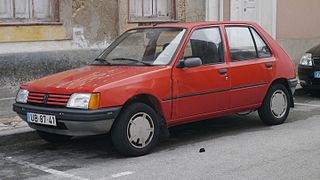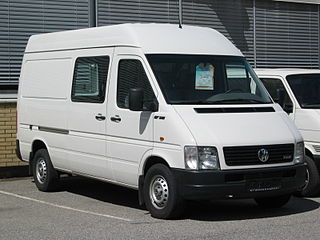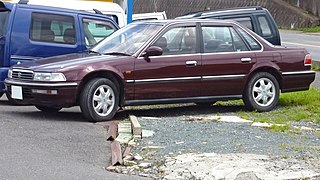
The Peugeot 205 is a supermini car produced by the French manufacturer Peugeot from 1983-1998.

The Audi 80 was a compact executive car produced by the Audi subdivision of the Volkswagen Group across four generations from 1966 to 1996. It shared its platform with the Volkswagen Passat from 1973 to 1986 and was available as a sedan, and station wagon) — the latter marketed by Audi as the Avant. The coupé and convertible models were not badged as members of the range but shared the same platform.

The Volkswagen LT was the largest light commercial panel van produced by Volkswagen from 1975 to 2006. Two generations were produced.

VR6 engines, and the later VR5 variants, are a family of internal combustion engines, characterised by a narrow-angle V engine configuration. Developed by the Volkswagen Group in the late 1980s, evolutions of these engines are still produced by them.

The Honda Ascot is a compact sedan manufactured by Honda and marketed only in Japan from 1989 to 1997. The first generation produced two versions based on the Honda Accord CB series called the Ascot and from 1993 to 1996 a "pillared hardtop" called the Ascot Innova. The Innova shared much of its mechanicals with the European-market Accord manufactured at the Honda UK facility in Swindon, England, and was essentially the badge engineered Rover 600. The second generation was a platform improvement, shared with the Japan-only sedan called the Honda Rafaga. The "Ascot" name was chosen with reference to the Ascot Racecourse and Ascot tie, in order to add the model an alleged air of class and elegance.
The Ferrari Dino engine is a line of mechanically similar V6 and V8 engines produced by Ferrari for about 40 years from late 1950s into the early 2000s.

The Lamborghini V8 is a ninety degree (90°) V8 petrol engine designed by Lamborghini in the 1970s for their less-expensive vehicles. It was only the second internal combustion engine ever developed by the company, and first saw production for the 1971 Lamborghini Urraco. It was designed by Gian Paolo Dallara. The all-aluminium alloy engine was introduced as a 2.5-litre variant, displacing 2,463 cc (150.3 cu in), but was expanded, by increasing the piston stroke to a 3.0-litre variant for 1975 - now displacing 2,997 cc (182.9 cu in).

The Lancia Fulvia is an automobile produced by Lancia between 1963 and 1976. Named after Via Fulvia, the Roman road leading from Tortona to Torino, it was introduced at the Geneva Motor Show in 1963 and manufactured in three variants: Berlina 4-door saloon, 2-door Coupé, and Sport, an alternative fastback coupé designed and built by Zagato on the Coupé floorpan.

The Renault Master is an upper medium size van produced by the French manufacturer Renault since 1980, now in its third generation. It replaced the earlier Saviem SG3 light trucks. Opel has sold versions of the second and third series vans as the Opel Movano in Continental Europe and Vauxhall Movano in the United Kingdom. All three generations have been designed and manufactured by Renault, irrespective of the brand.
Lancia introduced its new aluminum flat-4 engine in 1960 for the Flavia. Though it was a pushrod engine, it was advanced for the time. The pushrod version of the Lancia boxer was only ever used in the Flavia, and its derivatives including the Lancia 2000. In 1976, a new overhead cam engine based on a similar layout was designed and brought into production in 2 and 2.5 litre forms fitted to the Gamma.

The Lancia Beta was an entry-level luxury car produced by Italian car manufacturer Lancia from 1972 to 1984. It was the first new model introduced by Lancia after it had been taken over by Fiat in 1969.
Multijet is Fiat Chrysler Automobiles' term for its current common rail direct injection turbodiesel engine range. Most of the Fiat, Alfa Romeo, Lancia range as well as certain Chrysler, RAM Trucks, Jeep and Maserati vehicles are equipped with Multijet engines. Ownership of some Fiat Multijet designs is shared with General Motors as part of a settlement of the failed merger between the two auto conglomerates. GM Powertrain Torino group in Turin, Italy manages their interest in these engines. Some PSA Peugeot Citroën diesel engines are also rebadged JTD units, and vice versa. Fiat's common rail diesel engine is also known as JTD, an initialism of Jet Turbo Diesel.

The Suzuki Jimny is a line of four-wheel drive off-road mini SUVs, made by Japanese automaker Suzuki since 1970. Originated as a car in the Japanese Kei car tax and legal class – a Kei car version is still made for the Japanese market today, as well as versions that exceed that class's legal limits, in Japan called the Jimny Sierra. The latter are also successfully sold in worldwide markets. Suzuki has sold 2.85 million of them in 194 countries from launch in April 1970 through September 2018.

The Lancia Kappa is an executive car produced by Italian automaker Lancia. It replaced the Thema as Lancia's flagship model in 1994 and was itself replaced by Lancia Thesis in 2001. It shared its platform with the Alfa Romeo 166 and was available as a saloon, estate or coupé. The Kappa was only available in left-hand drive, as Lancia pulled out of right-hand drive markets after the demise of the Thema.

The Lancia Gamma is an executive car manufactured and marketed by the Lancia subdivision of Fiat. Following its debut at the 1976 Geneva Motor Show as Lancia's new flagship, the Gamma was marketed as 4-door fastback saloon as the Berlina (1976-1984) and as 2-door coupé (1977-1984), both designed by Pininfarina — with 15,272 and 6,790 manufactured, respectively. The Gamma superseded the Lancia Flavia.

The Volkswagen air-cooled engine is an air-cooled boxer engine with four horizontally opposed cast-iron cylinders, cast aluminum alloy cylinder heads and pistons, magnesium-alloy crankcase, and forged steel crankshaft and connecting rods.

The Toyota Carina line of large family cars was introduced in Japan in 1970. It was introduced in Europe in 1971, with A40 and A60 series subsequently appearing soon after their introductions in Japan. In 1984, the A60 series Carina was replaced in the European market by the "Carina II" - essentially a rebranding of the T150 series Toyota Corona launched the previous year in Japan, with some minor alterations to suit the European markets. This trend of Coronas rebadged as Carinas produced for the European market continued for two more generations, with the second Carina II in 1988 and the Carina E in 1992.
The Lancia Ro, Lancia Ro-Ro and Lancia 3Ro were 4x2 heavy trucks built by Italian manufacturer Lancia from the 1930s through the 1940s for military and civilian use. The 2-cylinder diesel Ro was produced from 1933 to 1939, the 3-cylinder diesel Ro-Ro from 1935 to 1939 and the improved 5-cylinder diesel 3Ro from 1938 to 1947.

The Nissan Junior was a series of medium-sized pickup trucks built from 1956 until 1982. It was introduced to fill the gap between the smaller, Datsun Bluebird based Datsun Truck, and heavier load capacity Nissans under the Nissan Diesel brand, like the 80-series trucks. After the merger with Prince Motor Company, the Junior and the Prince Miler were combined, sharing most of the characteristics, with the Junior sold at Nissan Bluebird Store Japanese dealerships, and the Miler sold at Nissan Prince Store until 1970.

The Lancia Superjolly is an alloy-bodied light commercial vehicle produced by the Italian manufacturer Lancia. The truck, which shares its 815.000 engine and some other mechanicals with the Lancia Flavia, is the successor of the Appia-based Lancia Jolly. The 1½ ton Superjolly has a longer wheelbase than its predecessor. The little truck was produced from 1963 to 1970 in Turin, Italy. The first model (315.000) was produced in 1674 examples, while 1272 of the 1.8-litre 315.024 model meant that overall production was 2948. The Superjolly has front-wheel drive with independent suspension, meaning that the loading area is uncommonly low. The subframe and drivetrain of the Flavia were used, with some modifications to handle heavier work, but the Superjolly also utilized parts from the Appia, Fulvia, and Flaminia ranges. A three-speed manual transmission was standard, although later models had the Flavia's fully synchronized four-speed.



















